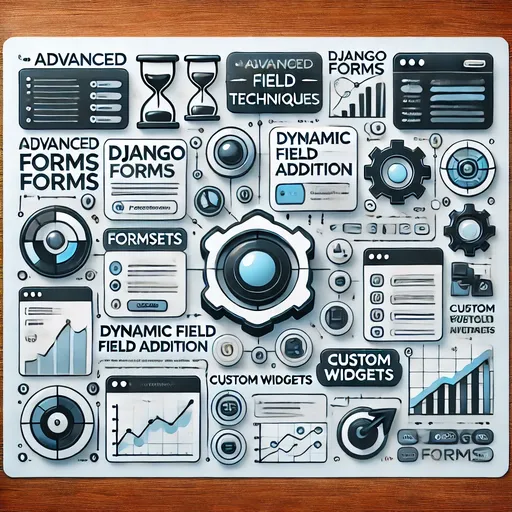Advanced Usage of Django Forms
Django Forms offers various advanced features in addition to basic data handling. In this article, we will discuss advanced usage of Django Forms, including FormSets, dynamic field addition, custom widgets, and performance optimization.
1. Using FormSets
1.1 What is a FormSet?
A FormSet is a feature that allows you to create multiple instances of the same form and process them at once. It is useful when creating or updating multiple objects.
1.2 Basic FormSet Example
Defining the Form
from django import forms
from django.forms import formset_factory
class ItemForm(forms.Form):
name = forms.CharField(max_length=50)
quantity = forms.IntegerField(min_value=1)
Creating the FormSet
ItemFormSet = formset_factory(ItemForm, extra=3)
Processing in the View
from django.shortcuts import render
def manage_items(request):
if request.method == 'POST':
formset = ItemFormSet(request.POST)
if formset.is_valid():
for form in formset:
print(form.cleaned_data)
else:
formset = ItemFormSet()
return render(request, 'manage_items.html', {'formset': formset})
Rendering the Template
<form method="post">
{% csrf_token %}
{{ formset.management_form }}
{% for form in formset %}
{{ form.as_p }}
{% endfor %}
<button type="submit">Submit</button>
</form>
2. Adding Dynamic Fields
2.1 The Need for Dynamic Fields
Dynamic fields are used when form fields need to be added dynamically based on user input or specific conditions.
2.2 Example of Adding Dynamic Fields
Defining the Form
class DynamicForm(forms.Form):
def __init__(self, *args, dynamic_fields=None, **kwargs):
super().__init__(*args, **kwargs)
if dynamic_fields:
for field_name, field in dynamic_fields.items():
self.fields[field_name] = field
Using in the View
from django import forms
def dynamic_form_view(request):
dynamic_fields = {
'extra_field_1': forms.CharField(label='Extra Field 1'),
'extra_field_2': forms.IntegerField(label='Extra Field 2', min_value=0),
}
form = DynamicForm(dynamic_fields=dynamic_fields)
return render(request, 'dynamic_form.html', {'form': form})
3. Creating Custom Widgets
3.1 What are Custom Widgets?
Custom widgets are used when special rendering or behavior is required beyond default Django widgets.
3.2 Example of a Custom Widget
Defining the Custom Widget
from django.forms.widgets import Widget
class CustomWidget(Widget):
template_name = 'widgets/custom_widget.html'
def __init__(self, attrs=None):
default_attrs = {'class': 'custom-widget'}
if attrs:
default_attrs.update(attrs)
super().__init__(default_attrs)
def format_value(self, value):
return value.upper() if value else ''
Using in the Form
class CustomWidgetForm(forms.Form):
custom_field = forms.CharField(widget=CustomWidget())
Rendering in the Template
widgets/custom_widget.html
<input type="text" name="{{ widget.name }}" value="{{ widget.value }}" class="{{ widget.attrs.class }}">
4. Performance Optimization for Forms
4.1 Minimizing Field Traversal
If a form contains too many fields, rendering performance can degrade. Remove unnecessary fields or manage them separately.
Example of Removing Fields
class OptimizedForm(forms.Form):
name = forms.CharField(max_length=100)
email = forms.EmailField()
age = forms.IntegerField()
def __init__(self, *args, **kwargs):
super().__init__(*args, **kwargs)
if 'skip_email' in kwargs.get('initial', {}):
self.fields.pop('email')
4.2 Using Form Caching
Caching form rendering results can reduce unnecessary calculations. Caching is primarily used alongside template caching.
5. Conclusion
The advanced usage of Django Forms provides powerful tools to dynamically extend forms or optimize performance to meet developers' needs. Appropriately utilize FormSets, dynamic field addition, custom widgets, and performance optimization methods to create more efficient and user-friendly forms in your projects.

This series concludes here, but feel free to request any additional topics you would like to cover. 😊

There are no comments.